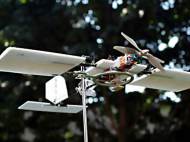MURI program – improving UAV agility in complex environments
 The Office of Naval Research (ONR) funded a Multidisciplinary University Research Initiative (MURI) program which examines birds’ perceptual and maneuvering abilities when flying at high speeds through complex environments, such as forests or urban settings in order to improve performance of small unmanned aerial vehicle (UAV) in those settings. Aside increasing their agility, these small UAVs could become lighter and less expensive.
The Office of Naval Research (ONR) funded a Multidisciplinary University Research Initiative (MURI) program which examines birds’ perceptual and maneuvering abilities when flying at high speeds through complex environments, such as forests or urban settings in order to improve performance of small unmanned aerial vehicle (UAV) in those settings. Aside increasing their agility, these small UAVs could become lighter and less expensive.
MURI is a five-year program where a group of researchers from several universities tries to understand why birds make particular flight path choices and how they can do so quickly at higher speeds than would be safe for current engineered air systems in these environments.
In the lab, researchers set up an artificial forest with tall pipes serving as trees at Harvard University’s Concord Field Station. Birds and a MIT-built UAV are wired with small digital video cameras and motion-capture technology. Both are studied in parallel to compare and learn from performance as the research progresses.
The goal is to develop and successfully demonstrate a small aircraft that can navigate obstacles in very complex and unstructured surroundings, while maintaining speeds as fast as 5 meters per second. The theoretical results being developed may also be applicable to larger UAVs for particular tasks, such as landing at difficult, unprepared sites.
“Autonomous systems technology can be a great way to deliver increased capability to the Navy and Marine Corps at an affordable price”, said Marc Steinberg, a research program officer in ONR’s Science of Autonomy Program. “We can provide warfighters with a lot more flexibility and enable new mission performance, from flight under a forest canopy and in urban canyons to damage control applications onboard ships. Flying animals provide evidence it is possible to build compact platforms with limited sensing that can safely move through challenging environments.”
The research revealed a theoretical speed at which the probability of a collision is high in forests with an average distribution of trees. So, if a UAV stays below that threshold, the probability of an accident lowers dramatically. The program also has begun to reveal the types of flight strategies used by birds in these environments.
“We want to build small-scale UAVs that can fly quickly through indoor and/or cluttered environments, but controlling these UAVs is very different than controlling a fighter jet flying up above the clouds”, said Dr. Russ Tedrake, X Consortium associate professor of electrical engineering and computer science and aeronautics and astronautics at MIT and the MURI lead. “To be successful, we have to solve a number of incredibly hard problems in computer vision and nonlinear control. This long-term project lets us focus on the basic research questions that will lead to fundamental results and, ultimately, dramatic new capabilities for UAVs.”
Increased agility enabled by the MURI project could eliminate the need for sensors currently used in UAVs such as laser-based ones that add cost and weight, and rely on lightweight digital video cameras as the main sensors instead.









Leave your response!